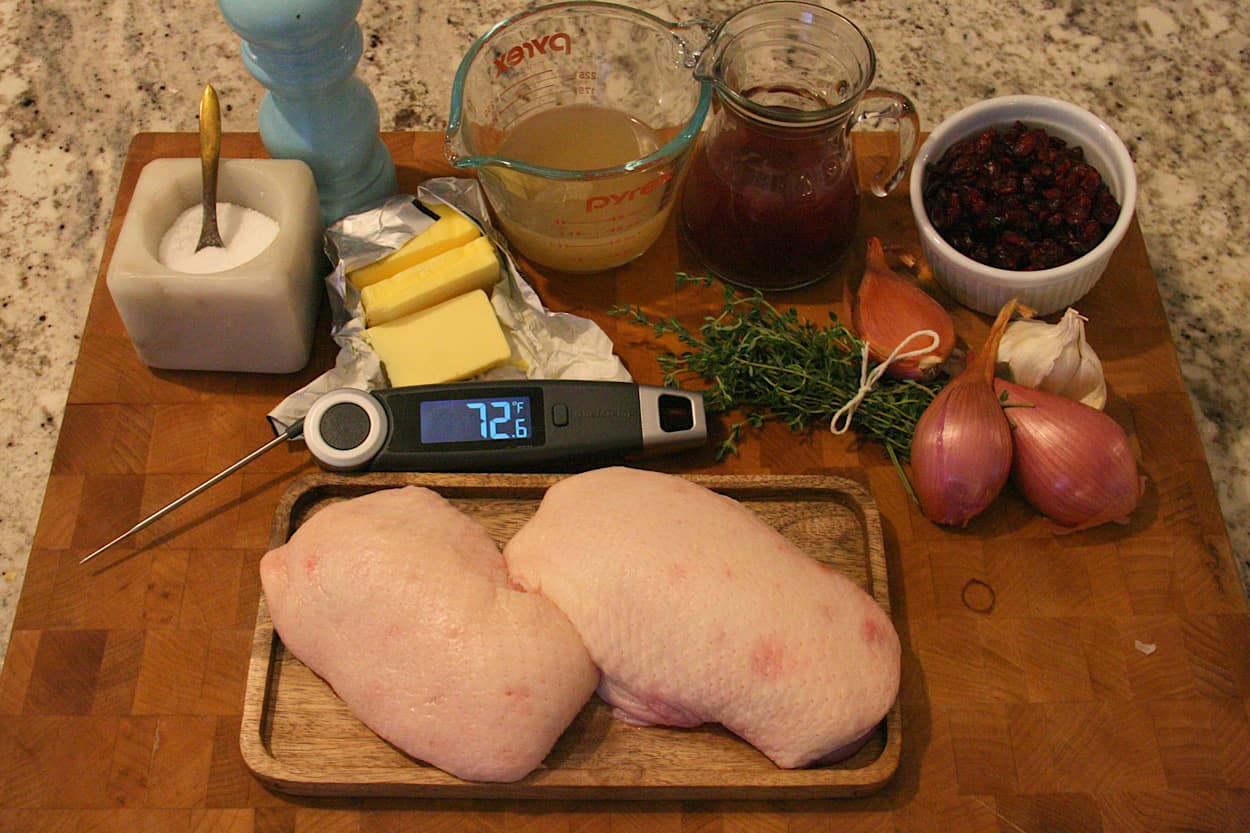
Pan Seared Duck Breast | Chefstemp
Understanding How to Pan Sear a Duck Breast
Duck is one of our favorite meats to cook, and it could be yours as well. The meat is tender and rich, with the unique flavor of a prime steak and poultry while the fat is the delicacy of choice for gastronomes the world over.
There are many people out there who have an aversion to duck, its too fatty, livery, or tough, and to those people we simply say, “You have never had perfectly cooked duck.” This is a unique animal and thus requires some specific, but very simple, preparation and techniques. In essence, the key to a perfectly cooked duck breast is time, and the right thermometer such as the Finaltouch X10.
COOKING TEMPS AND FOOD SAFETY
We need to address the elephant in the room, the USDA cooking temperature guide. Since duck is a bird, it falls under the category or poultry for cooking temperatures. That would mean that the food safe temperature of a duck should be 165°F (74°C). But here is the problem, at that final temperature you would be left with a dry, leathery, and livery cut of meat that is a far cry from the heights of flavor it should be.
Chicken must be cooked to 165°F (74°C) for several reasons most notably being killing salmonella. But a duck is not a chicken. One of the key differences is the muscle structure of the meat. Ducks are migratory birds built of slow twitch muscles that requires a lot of oxygen. That means the meat has a tighter structure and a high amount of myoglobin, the same protein that gives steak its “steak-ie” flavor.
These factors, along with the way most ducks are raised, limit the exposure to the harmful bacteria and allow you to cook the meat to a much lower temperature. So is it 100% safe to eat with no risks, no, but neither is a medium rare steak or an over easy egg.
A SLOW APPROACH FOR PERFECTLY RENDERED FAT
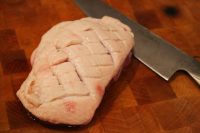
Duck fat is the crown jewel of fats. Peek in any high-end kitchen and something is being fried, roasted, or seared in duck fat. A duck breast has a thick layer of subcutaneous fat on top of the breast that is used to keep the duck warm while swimming. The perfect finished duck breast has tender and juicy meat topped with a thin layer of fat that is soft on the breast side and crispy on the outside. To achieve this, we need to approach our finished cooking temperature low and slow.
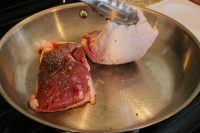
We start by scoring the skin lightly with a very sharp knife in a crosshatch pattern. You need to use a light hand here and not press too hard because you do not wat to cut all the way through the skin into the flesh. Scoring the skin increases the surface area exposing more of the fat to the heat. It also creates openings for the fat to render out of the skin and into the pan.
Next liberally salt the breast on the fat side and lightly on the flesh side, topping the flesh side only with some black pepper. Allow this to rest for 5-10 minutes in your refrigerator before moving to the pan.
SEARING THE DUCK BREAST
The term searing is a bit of a misnomer since searing implies a high heat and fast movements. We are instead going to start with a cold breast in a cold pan. The only trick is figuring out the proper flame setting, for us we were able to user the largest burner on our stove set to medium for the perfect sweet spot of heat. Allow the breast to sit in the pan for about 5 minutes, you are looking for the soft sound of fat gently bubbling away and akin to a gentle rain on your roof. That is the sweet spot, make any adjustments to your flame to achieve this activity. After a total of 8 minutes, remove the breasts and drain the fat from the pan, immediately return the breasts back to the skillet. Save this fat, its culinary gold and will make the best roasted potatoes you have ever had!
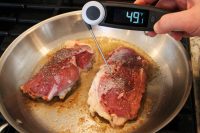
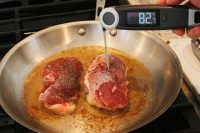
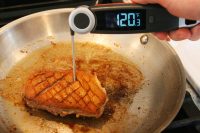
FRUIT AND WINE: THE FRIEND OF DUCK
Once you have removed the duck it is time to build the sauce. Most recipes for duck have a sweet sauce, usually a citrus or dark berry component, to cut through the richness and fat of the meat. This sauce is built with pinot noir, cherries, and thyme. Start by pouring out all but a tablespoon of the duck fat then add the shallots to the pan. Sautee the shallots till just brown, scraping up the browned bits in the pan. Once the shallots are browned add the garlic and thyme.
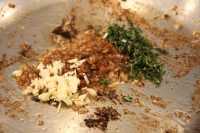
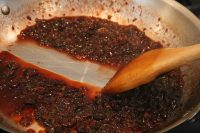
Continue to sauté for an additional minute. Add the dried cherries, cook for an additional 30 seconds, then add the red wine. Scrape up all the brown bits from the pan and cook till the sauce has reduced and thickened. Add the chicken stock and continue to simmer till the sauce is again reduced and thickened. Turn off the heat and in the butter till you have an emulsified sauce.
Slice the duck across the breast, making your slices not more than a 1/3rd of an inch thick. This will give you the perfect ratio of crispy skin, fat, and flavorful meat.
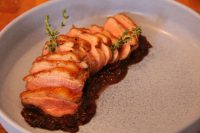
PERFECTLY PAN SEARED DUCK BREAST
INGREDIENTS
- 2 Duck breasts
- Salt, Cracked Black Pepper
- 1 large Shallot, diced
- 1 clove garlic, diced
- 2 tsp Thyme, chopped
- 1/3 C Dried Cherries
- 1/3 C Red Wine
- 1/3 C Chicken Stock
- 2T Butter
INSTRUCTIONS
- Using a sharp knife and very little pressure, score the skin on the duck breast almost down to the flesh.
- Liberally salt the skin side and lightly on the flesh side. Finish the flesh side with a little cracked black pepper.
- Allow this to sit in your refrigerator for 5- 10 minutes.
- Place the cold duck breasts in a cold heavy bottomed skillet. Turn on the heat to medium and let cook for five minutes.
- You want to make sure you are hearing and seeing a gentle bubbling from all around the duck, no big pops or loud sizzling. Adjust your heat accordingly till you achieve the proper sound.
- After five minutes, remove the duck breasts and drain the fat from the pan (Make sure to save this fat!). Return the duck and continue to cook for an additional 5-8 minutes then repeat the draining.
- Once the breasts have reached an internal temperature of 120°F (49°C) flip the duck breast over and increase the heat to medium high and cook on the flesh side till the breast registers 125°F (52°C).
- Remove from the heat and let rest on a plate skin side up. Now it is time to make the sauce.
- Add the dried cherries, cook for an additional 30 seconds, then add the red wine.
- Scrape up all the brown bits from the pan and cook till the sauce has reduced and thickened.
- Add the chicken stock and continue to simmer till the sauce is again reduced and thickened.
- Turn off the heat and whisk in the butter till you have an emulsified sauce.
Discover Other ChefsTemp Products
Discover more recipes and learn kitchen tricks by joining our cooking family on Facebook.
You may also like:















